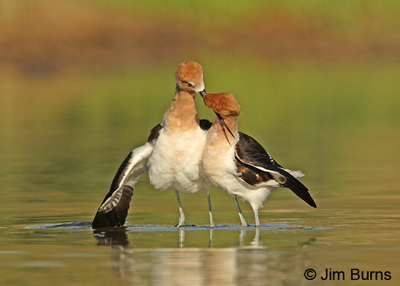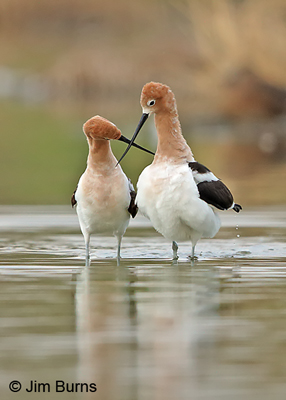
As the main focus of my bird photography has gradually evolved from portraits through flight into action, I have tried more and more to capture what I call lifestyle, or what one birding magazine calls “the secret life of birds.” This is behavior that casual observers, or hard core listers who “tick and run,” often miss because they don’t spend the time or patience to observe. Often this simply involves “pulling back the curtain” on birds’ daily activities. Sometimes, when luck and timing intersect, it illuminates, as I think this shot of American Avocets does, the very essence of a species.
“Avocet” comes to us from an Italian word meaning “graceful bird.” The Italian who coined this phrase certainly got it right, from the long legs, to the elegant sweeping motion of the uniquely upcurved bill seen when the birds are feeding, to the post copulatory dance captured in my image here. The male, larger and on the left, has just dismounted from his mate, and the dance has just begun. Typically the dance lasts about six seconds. Don’t blink. The dance is much cooler than the cloacal kiss itself.
There will be those quibblers who will say I didn’t capture the crossed bills, the signature visual takeaway for those lucky enough to witness paired avocets doing their thing together. Nonetheless, what I love about the angle of view in this image is the position of the male’s wings, his right one spread for balance on the dismount, his left one draped over his mate, and if you accuse me of anthropomorphism when I say he appears lovingly protective, so be it.
There is always something about water birds in water. The camera loves the ripples and reflections, but the small pool of glass directly beneath the avocets’ conjoined breasts speaks to the tranquility in the aftermath of coitus. Though the crossing of bills is not evident from this angle, the birds are obviously looking into one another’s eyes, sealing the feeling of intimacy conveyed by the image. The telephoto lens has rendered the background clean, the russet tones of its dried foliage serendipitously matching the cinnamons of the breeding plumaged birds.
Avocets are eighteen inches in length, migratory, and drably gray-headed in non-breeding winter plumage. They nest in the open on bare ground, typically near water, the nest itself a scrape filled with rocks, down, and debris, sometimes built up into a mound. Both parents build the nest and incubate, and the species often nests in loose colonies. The broken wing display is used to distract nest predators. Pairs are seasonally monogamous, but do not mate for life. Diet includes aquatic insects, crustaceans, and brine flies.
Avocet population nationwide seems to be on the increase. They were not found breeding in Arizona until 1965, but can be found now, late February through October, scattered throughout the state at places like Whitewater Draw, shallow lakes and ponds near Phoenix, west through the Arlington Valley, and south to Painted Rock Dam. They also nest periodically along the Santa Cruz River and in stock ponds on tribal lands.
These two images of dancing American Avocets were taken at the Gilbert Riparian Preserve, the nearest best place to catch a glimpse into the secret life of our most beautiful shorebird.
